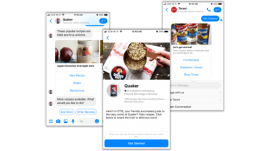Quick guidelines for getting users info they need in chatbots


Image from Reve Marketing
It’s best to think of a text-based chatbot as an “automated customer service rep.”
That’s the advice from Kaye Chapman, learning and development manager at digital engagement platform Comm100. As a conversational format sometimes assisted by AI, chatbots provide a different opportunity for marketers than, say, the structure and presentation of information in pages or screens for websites or mobile apps.
Conversations, not pages
If you think of a chatbot as just a “website with interaction,” she said, you don’t focus on the ways it can lead to your desired outcome, which might be making a sale or resolving a customer’s issue.
A web page presents a chunk of info that users find through navigational clicks or a site search, whereas a text-based chatbot presents information in small bites based on inputs from the user; it’s a different kind of information gathering and requires a different presentation.
Because of that central difference, it’s important to keep a chatbot’s information hierarchy relatively simple and shallow, said Vivek Lakshman, co-founder and VP of products at Reve Marketing, which offers chatbot creation and deployment.
Minimum before choices
Lakshman suggests that a marketer’s operational question in designing chatbot information flow should be: What is the minimal relevancy of input before presenting choices?
In other words: If you ask a chatbot for shoes, you should quickly see shoe choices.
One way to flatten the hierarchy, he said, is to group products in ways they may not be grouped on a site, followed by a drilldown. Shoes might be included in a new, higher level of “footwear,” for instance, that includes shoes, sneakers, boots, socks and so on.
Another way to flatten the drilldown is to determine the user’s persona and need up front via queries from the chatbot, instead of assuming the user’s persona will reveal itself through choices.
A different kind of persona
Website information designers, of course, frequently create profiles of targeted users, called personas, in order to determine their approaches and needs. One persona, for example, might be a mother of small children, while another is a male senior citizen. The typical information quests of each user type is then taken into account in deciding how the information is grouped, structured and reached by menus or site search.
But a chatbot can simply ask up front: how old are you and what are you looking for? This establishes the persona and need immediately, so that end-result choices can be presented more quickly. It’s a different kind of choice tree.
Conversational flow also means that a marketer can inject highlighted information at specific times in the interaction that might increase their impact. A daily special, for instance, doesn’t need to be on the site home page or in a pop-up window, but can be injected into the conversational flow at opportune moments, such as when it seems the user’s answers point away from a purchase.
Different background info for chatbots
Not all chatbot interaction is created equal, of course. In addition to such obvious differences as the quality of any assisting AI, there’s also the basic fact of differences in how much is known about a user.
A chatbot where a user has logged on with credentials from a brand website, for instance, will likely have more brand-related purchase history on the user than, say, a chatbot on Facebook Messenger, where the user is logged on with Facebook credentials.
Text-based chatbots can be an integral part of a brand’s marketing and customer service team, if brand information is designed for the particular requirements of this delivery mechanism.
If not, users can get wary of using chatbots that are less efficient than other means in helping them find what they are looking for — even if the idea of chatting initially seems more engaging.
This story first appeared on MarTech Today. For more on marketing technology, click here.
The post Quick guidelines for getting users info they need in chatbots appeared first on Marketing Land.
From our sponsors: Quick guidelines for getting users info they need in chatbots



